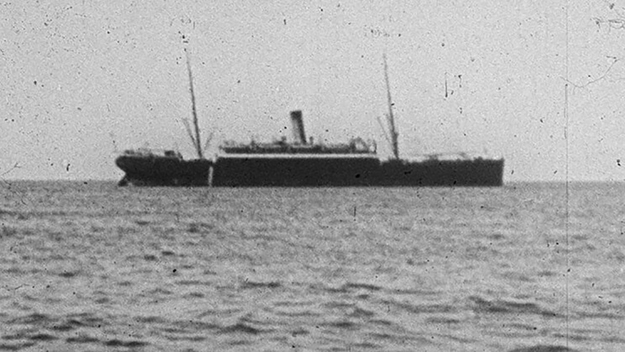Seeing Double: Ships in the Night
This article appeared in the March 16, 2023 edition of The Film Comment Letter, our free weekly newsletter featuring original film criticism and writing. Sign up for the Letter here.

Navigators (Noah Teichner, 2022)
“Our story deals with one of those queer tricks that Fate sometimes plays.” Buster Keaton’s 1924 seafaring silent comedy, The Navigator, opens with a title card bearing these words. The “queer trick” it references unfolds early in the film as a series of mix-ups that puts the rich fool Rollo Treadway (Keaton) and the girl who’d recently turned down his marriage proposal (Kathryn McGuire) together on the Navigator—a big, empty boat adrift on the Pacific Ocean, and the venue for the ensuing five reels of high-art burlesque.
That title card also appears toward the end of Navigators, the debut film of researcher and artist Noah Teichner, which premiered at last year’s Cinéma du Réel festival and is now available on demand from Grasshopper Film. Teichner’s film takes as its starting point a different queer trick of fate, a kernel of little-known trivia about The Navigator: the boat Keaton filmed on for 10 weeks off Catalina Island was formerly the U.S.A.T. Buford, a ship the U.S. government used in 1919 to expel hundreds of anarchists—some self-proclaimed, others alleged—to Russia. Notably, prominent radicals Emma Goldman and Alexander Berkman were among these deportees. The form of Teichner’s film is, like the famous movie-hall dream sequence in Keaton’s Sherlock Jr., almost surrealist: a split-screen juxtaposition of The Navigator and various archival materials chronicling the deportees’ journey on the same vessel. With its rich layering of film, photos, text, and sound, Navigators is not just a recounting of the past but an inspired cross-pollination of two distinct histories.
The documentary displays artfully rendered excerpts from myriad accounts of the deportation—including Berkman’s book The Bolshevik Myth, Goldman’s My Disillusionment in Russia, letters Goldman wrote to her niece Stella Ballantine and provocateur novelist Frank Harris, police files, and reports from newspapers—alongside hauntingly decelerated extracts of Keaton’s films. We see the comedian goofing around in slow motion in the same setting where, just a few years prior, Berkman was “cooped up in crowded, ill-smelling steerage quarters” for almost a month. In Berkman’s account of the journey, there is a mix of shock (“we were kidnapped, literally kidnapped out of bed in the dead of night”); excitement about returning to a Russia free from monarchy; and anxiety about the political bias of the Bolshevik regime against anarchists. Berkman also observed that “the powerful American Government never appeared to me in a more ridiculous light.”
He was painfully aware of the political stunt the deportees had been caught up in—a stunt foreshadowing the malicious “gag” of Southern governors shipping migrants to Washington, D.C. and Martha’s Vineyard in the present day. The combination of suffering, sadness, and mirth he recounts amid this farce—what Goldman called “a whole stupid performance”—finds an eerie visual corollary in the Great Stone Face of Keaton stoically playing out the slapstick antics of one of cinema’s foundational comedies. The beatings he’d take for a laugh!
The Buford docked in Hanko, Finland on January 16, 1920, 26 days after leaving New York Harbor. Its passengers were loaded onto boxcars and escorted to the Russian border by Finnish soldiers. After about two years in Bolshevik Russia, initial excitement faded into disillusionment for both Berkman and Goldman—anarchists were in jail there, too—and they left for Berlin. By then, the Buford was nearing the end of its military life, floating off the pages of U.S. political history and into the footnotes of cinema history, both of which Teichner has passionately plumbed with Navigators.
Teichner’s success in marshaling a range of citations to track the ship’s journey from capital-h History to Hollywood brought to my mind Jean-Luc Godard’s Film socialisme (2010), in which a torrent of literary and visual references coalesce in a fiction that extends another murky thread of 20th-century maritime history. The film’s characters, with Soviet, Nazi, and French Resistance affiliations, are in search of gold, lost in the Mediterranean, that the Spanish Republic sent by boat to Russia for safekeeping during the Spanish Civil War. In a trick of fate akin to the case of the Buford, though one that unfolded in reverse, much of Film socialisme was shot on the Costa Concordia cruise ship a few years before it hit a rock formation off the coast of Tuscany, resulting in the deaths of 32 passengers and crew. The accident landed the captain a 16-year prison sentence for manslaughter. As demonstrated in 2018’s Film catastrophe, directed by Paul Grivas (one of the cinematographers on Film socialisme), footage shot by panicked passengers on the sinking ship rhymes disturbingly well with images filmed by Godard on the same location several years earlier—so that Godard’s vision of a Europe where collectivism has been compromised by gauche materialism now feels eerily morbid.
Film socialisme lands on the side of fiction and Navigators on the side of documentary, but they both rely on a painstaking assemblage of primary sources to emphasize history as a vessel ripe for repurposing—and they both suggest convincingly that cinema is the ideal tool for the job. For while Teichner studiously exhibits his carefully collected sources on screen, the power of his film ultimately lies in its speculative thrust: Navigators ends with an intertitle that imagines Berkman stumbling upon his old conveyance in a screening of Keaton’s classic in a Parisian cinema, giving fiction its proper place next to fact in every good story.
Jamie Aylward is a critic and writer based in Paris, France.







